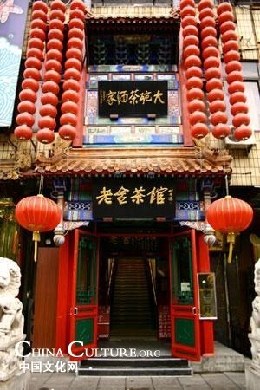Long ago, teahouses were the centre of social activity and bubbled with the chatter of people from all walks of life in Beijing. In the old teahouses noblemen, imperial officials, touts and peddlers chose their teas carefully and caught up on the day.

Lao She Teahouse
Today, the Tianqiao Le Teahouse still keeps the typical old Beijing style. A loud announcement in the Beijing dialect from doormen dressed in traditional long gown welcomes you to the Tianqiao Le Teahouse. Round wooden pillars support the protruding balconies fashioned according to ancient Chinese style. Black and white documentary photos of old Beijing folk artists line the white wall. Beneath a small stage, ancient style rectangular tables and chairs occupy most of the hall that is this teahouse. This could have been a typical place a hundred years ago where people sipped tea and ate snacks while watching a Peking Opera performance -- a scene often seen in the movies.
Located near the Tianqiao area in the southern part of Beijing, the teahouse's structure, a single building made entirely of wood, is said to have been built in 1933 by a warlord. Today, as much of Chinese vaudeville is revived on its stage, this has also become an important spot for people to reminiscence about old Tianqiao folk culture.
Tianqiao Le is also a kind of Mecca for crosstalk fans. Every week, from Thursday to Saturday, the teahouse holds cross-talk evening specials. With 20 Yuan, you can enjoy a whole evening's worth of fun and humor, sometimes with the hottest crosstalk performer around, Guo Degang, who rose from anonymity to stardom in this very teahouse.
Today, teahouses in Beijing still have the same function but with not quite so much bustle. The traditional teahouses in Beijing provides foreigners with a cultural feast, while it lets the locals come back to Old Beijing.
Another best choice of traditional teahouses is the Lao She Teahouse at Building 3, Qianmen West Avenue, Xuanwu District.